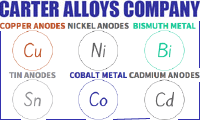
-----
Carbonate problems in Copper Cyanide Plating
Q. I have a lot of problems with a high level of Carbonates in my copper CN bath. Why it grows so fast? How to reduce it?
Paulo- Caxias do Sul, RS Brazil
2003
A. CARBONATE BUILD UP CAN BE BROUGHT DOWN BY CHILLING THE BATH OR BY TREATING WITH CALCIUM OXIDE, AND CARBON TREAT THE BATH, CARBONATE SETTLES AS CALCIUM CARBONATE.

Panjala Mukesh
fashion jewelry mfgr.
Hyderabad, India
2003
A. In the cyanide baths, the carbonate can be formed by different ways, but can be formed mostly by absorption of carbon dioxide from the air (reactions 1A and 1B) or by hydrolysis of the cyanide. 2XCN + CO2 + H2O = X2CO3 + 2HCN (1A),X: Na or K 2XOH + CO2 = X2CO3 + H2O (1B), X: Na or K Keep the concentration of sodium carbonate in the bath below of about 75 g/L (or below of about 100 g/L of potassium carbonate) The are two different ways that can be used to reduction of the carbonate concentration: one can be done by cooling the bath and other can be done by precipitation with barium hydroxide.
Jean Vicente Ferrari- São Paulo, São Paulo State, Brazil
2003
A. Are you using air to agitate the tank , because that will push your carbonates as will a pump that is cavitating . The cooling of the tank will only work if you are using Sodium Cyanide, not Potassium .
Dave Brackenridgeaerospace plating - Germiston, South Africa
2003
A. 1. pH greater to 12
2. Temperature greater than 50 °C
3. CN frees Too much 30 g/L
4. NaOH too much :
Use H2O2 and activated charcoal
ivanoguerauniversidad - Medellin-Colombia
2003
!! Whenever the topic of freezing out Carbonates arises, I feel compelled to issue a friendly bit of advice.
Throughout my career, I have heard knowledgeable platers talk about high carbonates. They were going to freeze it out by adding dry ice to the tank. Well "DON'T EVER DO IT."
Dry Ice is Carbon Dioxide, which forms Carbonic Acid in solution. This reacts with cyanide in solution and forms poisonous Hydrogen Cyanide gas. Repeat: DON'T DO IT.
Many years ago, someone published a "tip" about using a "Dry Ice Tube" in their bath to rapidly freeze out carbonates. A tube, sealed watertight at the bottom, was filled with dry ice and inserted into the cyanide tank. The carbonate crystals would form on the outside of the tube and could be scraped off and discarded.
Use refrigeration devices to achieve the carbonate crystallization. You may even have a special tank with freezer coils. If you also do hard coat anodizing, you may have surplus cooling available for this purpose.

Ed Budman [dec]
- Pennsylvania
With deep sadness we advise that our good friend Ed passed away Nov. 24, 2018
2003
Q. What kind of treatment can I use to reduce carbonates in a Cyanide Copper bath. I don't want use freeze method.
IBARRA GUADALUPESALES - MEXICO
Q. Does anybody know how to remove carbonates in a plain cyanide copper bath
Calcium hydroxide how much
Barium salts are any useful?
cooling the bath to 30 degrees?
plating shop - Bucaramanga Santander Colombia
December 1, 2009
A. For Calcium Hydroxide the reaction is 0.7 ounces of calcium hydroxide removes 1 ounce of carbonate.
The complete procedures for the various methods of carbonate removal are discussed in this paper:
nmfrc.org/subs/history/oct1953c.cfm
- Calgary, Alberta, Canada
August 12, 2013
Q. We are having an unusual red color on the parts in a copper cyanide bath with 80 amp. We lower amps to 20 and the color is expected but the plating time is long, over 90 minutes in an usual 45 min plating desired time frame
1. pH is 14.7 (how can we lower it?)
2. Potassium carbonate's is 18.8 oz/gal ( We use potassium cyanide, Can we begin introducing sodium cyanide so we are able to freeze carbonates. Will there be or has anybody encounter any issues if we start adding sodium cyanide when we have a copper potassium cyanide bath? The tank volume is 635 gallons) KOH and Rochelle salts
⇦ on
eBay
or
Amazon [affil link]
are at optimum concentration.
Your response(s) will be greatly appreciated.
Sincerely,
- Santa Fe Springs, California USA
May 15, 2019
Carbonate removal, specifically with the use of Calcium Hydroxide
Q. I am inquiring of my fellow platers if anyone uses the precipitate method with calcium Hydroxide to remove carbonates from a Sodium Cyanide plating bath. I am looking for an alternative method in lieu of a freeze out. My two concerns using this method:
1. Am I able to return the solution to the bath after filtration with no amounts of calcium left over?
2. Am I able to treat the precipitate (calcium carbonate) in the same way as wastewater since there will be some amount of Cyanide left over after filtration.
I know these are loaded questions and dependent upon how much calcium hydroxide is used. But, what I seek is, essentially, a personal experience using this method for carbonate removal and if it is effective for your plating process and worth trying.
Sadly, there is not much information out there on this process.
shop chemist - Saint George, Utah United States
August 28, 2019
A. Hi Jennifer. We added your question to a thread where the subject has already been discussed. Steven Gorzo suggested looking at nmfrc.org/subs/history/oct1953c.cfm
Good luck!
Regards,

Ted Mooney, P.E. RET
Striving to live Aloha
finishing.com - Pine Beach, New Jersey
Ted is available for instant help
or longer-term assistance.
September 2019
|
Q. Thank you so much for your response, Mr. Mooney, and also for posting this to the thread. The article suggested by Mr. Gorzo is very useful in learning the process of how to precipitate the carbonates using the calcium hydroxide method, although, there was nothing said about what is done with the precipitate (Calcium Carbonate) and if the filtered cyanide solution can be reused in the bath or if there might be any residual calcium left over after filtration. Due to these questions after reading the article, I thought to present this to the forum for those to respond who use the calcium hydroxide process for carbonate reduction in a cyanide bath. Specifically, I am looking for another's personal experience with this method to help answer these questions for me. Jennifer Farner [returning]Shop Chemist - Saint George, Utah September 10, 2019 A. Hi, Jennifer - Lod, Israel September 11, 2019 |
Carbonate removal from a potassium cyanide bronze bath
Q. I am a process engineer and we are using a potassium based bronze bath (~6000 gallons) for barrel plating. The finish is matte or semi-bright. After a few weeks we exceeded our carbonate limit of about 260 g/L and started bailing out solution. We are using copper and carbon anodes. I have reviewed a 1953 article by Modjeska but I still have a few basic questions.
1. Does treating with calcium hydrate generate a lot of sludge?
2. What purity of calcium hydrate is needed?
3. Is it ok to have ~ 3% of MgO impurity in the calcium hydrate?
Thank you in advance,
- Jonesborough, Tennessee, USA
June 24, 2020
adv.: Supplier of Copper Anodes, Nickel Anodes, Bismuth Metal, & Other Metal Products for Industry & The Arts

Q, A, or Comment on THIS thread -or- Start a NEW Thread
 it will pass.
it will pass.